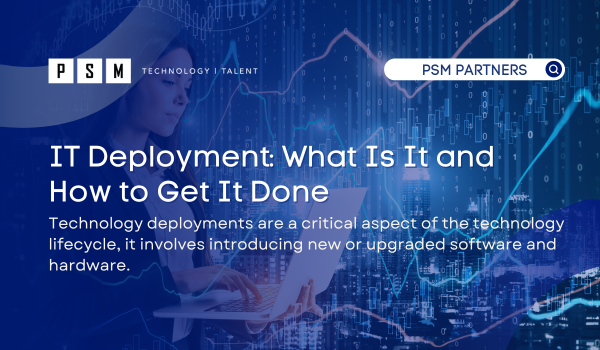Table of Contents
ToggleAs technology advances, it’s important for businesses to keep up with the latest software and hardware updates to remain competitive and secure. The deployment of technology is a critical aspect of the technology lifecycle, however, upgrading personal computers and laptops can be a daunting and time-consuming task for businesses. That’s where vendor deployments play a role.
Mere plug-ins or simple installations won’t cut it, security and system dependencies must be taken into consideration to avoid potential risks. An outsourced service partner can act as an extension of the team, providing cost-effective and efficient technology deployment services that maximize budget and value for customers. High-quality deployments can set customers and companies up for lasting success with minimal downtime to their systems. Following best practice in technology deployment ensures efficiency, security, and quality throughout the process.
Technology deployment is a vital process that involves introducing new or upgraded software and hardware to one or more users or systems in an organization. It encompasses the seamless integration of interdependent accessories like docking stations, printers, and computer monitors, ensuring that the new technology works in harmony with the existing infrastructure. The development process typically includes planning, development, testing, and deployment stages to ensure a structured and successful rollout.
The ultimate goal when deploying technology is to equip the systems with the necessary access to various computer files and software to ensure optimal functionality with minimal disruptions to your employees or customers. However, new computers don’t come preconfigured to cater to the specific needs of your office and employees.
Introduction to IT Infrastructure Deployment
IT infrastructure deployment forms the backbone of any successful software development and deployment process. It involves the careful setup and configuration of all the necessary hardware and software components—such as servers, networks, and storage systems—that support your business applications. This critical aspect of deployment ensures that your software runs smoothly, securely, and efficiently within your organization’s IT environment.
A well-executed infrastructure deployment process typically unfolds over several stages, beginning with detailed planning and moving through rigorous testing before reaching actual deployment. Each stage requires close coordination between the IT team and other stakeholders to minimize potential risks and ensure that the infrastructure can support both current and future business needs. By investing in careful planning and collaboration, organizations can avoid costly disruptions and lay a solid foundation for ongoing software development and support.
How to Deploy New Technology
When deploying new technology, you can either build an in-house team within your organization with the necessary resources or you can outsource to a service partner that has the expertise and infrastructure to handle it for you.
When you outsource to a service provider, they can provide support for your brand throughout the entire product and customer lifecycle. This allows your essential resources to concentrate on your core business and digital transformation initiatives rather than managing logistics and details. Vendors will handle the project management, planning/coordination, scheduling, controlling, testing and deploying. Vendors also help implement new systems and strategies within organizations, ensuring a structured and successful rollout. By outsourcing this sometimes complex and tedious aspect of your business, you can benefit from increased revenue, faster time-to-market, greater cost savings, and reduced complexity. An effective approach to deployment includes real-time visibility, automation, and best practices to ensure smooth and secure software rollouts.

Advantages of Hiring a Vendor for Technology Deployment Services:
Deploying the latest technology products can provide businesses with real-time insights into the daily flow of their activity, offering greater clarity and detail than ever before.
To fully capitalize on the potential benefits of new technology, businesses should consider hiring a vendor for technology deployment. By doing so, they can tap into a host of advantages that can help them achieve their objectives. These benefits include:
Expertise: Vendors have become indispensable for businesses that seek to deploy cutting-edge technologies. Vendors have the necessary expertise and experience to upgrade and update computers efficiently and effectively. They manage deployments across multiple environments—such as staging, testing, and live environments—to ensure updates are thoroughly tested and safely released to production.
Time-Saving: Technology deployment can enhance business procedures and automate repetitive tasks, unlocking time for employees to focus on higher-value work. Upgrading and updating computers can be time-consuming for in-house IT staff. Hiring a vendor can save time and free up staff to focus on other tasks.
Cost-Effective: Upgrading computers and laptops can be expensive, especially if the company needs to purchase new hardware or software licenses. However, vendors often have access to bulk discounts and can provide cost-effective solutions for companies. Vendors also provide cost-effective solutions for upgrading and updating computers. Up-to-date technologies can help a business in reducing manual labor and improving employee productivity, which can result in substantial cost savings over time.
Security: Working with an experienced, reliable vendor allows businesses to recognize that the technology being implemented into the business is up to date, secure, and monitored by professionals. Vendors can ensure that computers are updated with the latest security patches and protocols to protect against cyber threats. A businesses security and privacy can be protected when a business works with a vendor. When upgrading personal computers and business laptops, there is always the risk of data breaches or cyber-attacks. However, vendors are experts in security and can ensure that all software and hardware upgrades are done securely and that all data is kept private. Additionally, vendors implement monitoring systems after deployment to maintain ongoing security and performance.
Compliance: When deploying new technologies, businesses should continuously consider compliance issues with vendors. Vendors can ensure that computers are updated to comply with industry-specific regulations and standards through careful planning and preparation.
Customization: Through soliciting the help of deployment professionals, businesses can tailor the technology deployment to respond to specific business constraints. With a comprehensive approach that examines both the hardware and software elements of the system, businesses can create an environment that is reliable and cost-effective while meeting all of the businesses requirements. Vendors can also help businesses test new configurations in a controlled environment before deploying them to the live environment, reducing the risk of issues in production.
Productivity: Using the latest technologies, people can achieve more in less time. Upgrading and updating computers can improve the productivity and efficiency of employees by providing them with faster, more reliable systems.
Disaster Recovery: Vendors can provide backup and disaster recovery services to ensure that data is protected in the event of a disaster. To mitigate disaster risks vendors should complete constant reviews and assessments of the businesses infrastructure, processes, policies and services while evaluating the effectiveness and relevance of any proactive measures that exist. Vendors also ensure that all updates are thoroughly tested in staging and test environments before being applied to the live server, minimizing the risk of disruptions.
Ongoing Support: It is essential to choose a vendor who can provide exceptional customer service and address any technical issues promptly, efficiently and with minimal disruption. Vendors can provide ongoing support and maintenance services to keep computers running smoothly. After each new release, vendors offer ongoing monitoring and support to quickly identify and resolve any issues that may arise.
Future-Proofing: Deploying the most up-to-date technology can provide businesses with a competitive advantage, helping them to remain relevant in their respective verticals. Vendors can help future-proof the company’s technology by keeping up with the latest trends and advancements in computer technology. They also ensure businesses stay current with each new version and software release, maintaining compatibility and security.
Release Management: Vendors manage the software release cycle, coordinating and controlling releases to ensure all users are working with the same version. This structured approach to software release and versioning helps maintain consistency, reliability, and smooth deployment of updates.
Are Technology Deployment Services Worth It?
Using an external vendor’s deployments can save businesses valuable time and resources. Upgrading multiple computers can be a tedious and time-consuming process. It requires someone to individually update each computer, which can take hours or even days, depending on the number of computers that need upgrading. Working with a vendor’s deployments to upgrade personal computers and business laptops can be highly beneficial for companies. It can save time and resources, improve the quality of the upgrade process, ensure security and privacy, be cost-effective and provide ongoing support and maintenance. Companies should consider using a vendor for their computer upgrades to stay competitive and ensure that their technology is up to date.
Conclusion and Future Directions
In summary, the software deployment process is a multifaceted journey that demands careful planning, coordination, and the right mix of tools and technologies. From the initial stages of infrastructure deployment and testing to the final step of actual deployment and post-deployment review, each phase plays a vital role in ensuring a successful outcome. As software and IT environments become increasingly complex, leveraging advanced deployment tools and embracing best practices will be more important than ever.
Looking ahead, the future of software deployment will likely be shaped by innovations such as artificial intelligence, machine learning, and the continued evolution of cloud-native technologies. These advancements promise to further streamline the deployment process, enhance security, and support the rapid delivery of new features to end users. By staying committed to careful planning, continuous improvement, and the adoption of new technologies, organizations can ensure that their software deployments remain effective, secure, and aligned with business objectives.
Contact us now to take advantage of our expert deployment services! To learn more, call PSM at (312) 940-7830 or submit a contact form today.
About the Author

Kayley O'Connell
Kayley O’Connell is a seasoned marketing leader with a passion for connecting people with the right technology solutions. As Senior Marketing Manager at PSM Partners, she drives brand strategy, demand generation, and go-to-market execution across IT services, cloud, security, and staffing. Kayley built PSM’s marketing engine from the ground up and continues to scale its impact through data-driven campaigns, creative storytelling, and strong cross-functional alignment.

